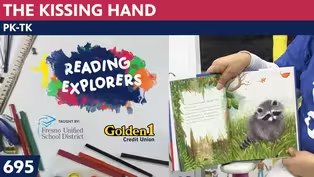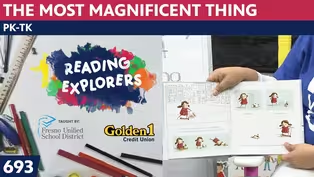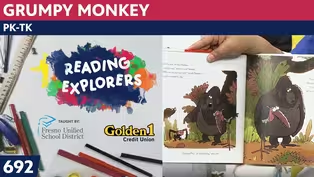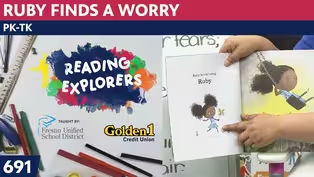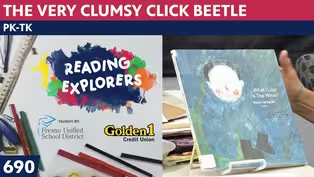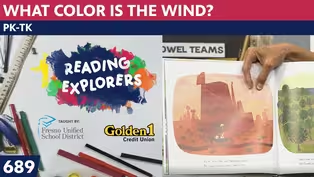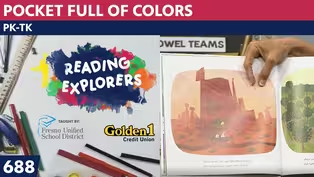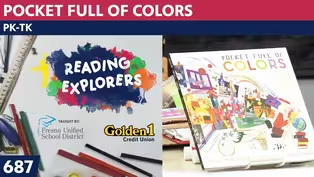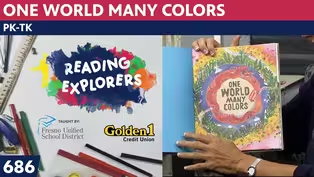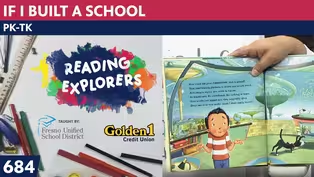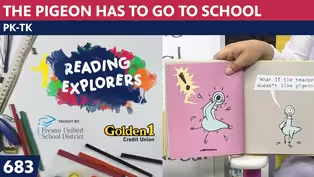
TK-384: Design Pigeons
Season 3 Episode 475 | 14m 2sVideo has Closed Captions
Join Mrs. Readwright at Camp Discovery!
Transitional Kindergarten teacher, Mrs. Readwright, welcomes students back to Camp Discovery, a fun learning space packed with reading adventures & fun games!
Problems playing video? | Closed Captioning Feedback
Problems playing video? | Closed Captioning Feedback
Reading Explorers is a local public television program presented by Valley PBS

TK-384: Design Pigeons
Season 3 Episode 475 | 14m 2sVideo has Closed Captions
Transitional Kindergarten teacher, Mrs. Readwright, welcomes students back to Camp Discovery, a fun learning space packed with reading adventures & fun games!
Problems playing video? | Closed Captioning Feedback
How to Watch Reading Explorers
Reading Explorers is available to stream on pbs.org and the free PBS App, available on iPhone, Apple TV, Android TV, Android smartphones, Amazon Fire TV, Amazon Fire Tablet, Roku, Samsung Smart TV, and Vizio.
Providing Support for PBS.org
Learn Moreabout PBS online sponsorshipMore from This Collection
Valley PBS and Fresno Unified School District have partnered with Golden 1 Credit Union to create Reading Explorers Lessons for grades Pre-Kindergarten through Third grade. The daily lessons will be taught by Fresno Unified School District teachers and are created to help students practice their reading skills and reinforce lessons during distance learning.
Video has Closed Captions
Valley PBS presents Reading Explorers Lessons for Pre-Kindergarten and TK. (26m 27s)
PK-TK-693-The Most Magnificent Thing
Video has Closed Captions
Valley PBS presents Reading Explorers Lessons for Pre-Kindergarten and TK. (26m 26s)
Video has Closed Captions
Valley PBS presents Reading Explorers Lessons for Pre-Kindergarten and TK. (26m 28s)
Video has Closed Captions
Valley PBS presents Reading Explorers Lessons for Pre-Kindergarten and TK. (26m 28s)
PK-TK-690: The Very Clumsy Click Beetle
Video has Closed Captions
Valley PBS presents Reading Explorers Lessons for Pre-Kindergarten and TK. (26m 22s)
PK-TK-689: What Color is the Wind?
Video has Closed Captions
Valley PBS presents Reading Explorers Lessons for Pre-Kindergarten and TK. (26m 21s)
PK-TK-688: Pocket Full of Colors
Video has Closed Captions
Valley PBS presents Reading Explorers Lessons for Pre-Kindergarten and TK. (25m 58s)
PK-TK-687: Dancing Through Fields of Colors
Video has Closed Captions
Valley PBS presents Reading Explorers Lessons for Pre-Kindergarten and TK. (26m 20s)
PK-TK-686: One World Many Colors
Video has Closed Captions
Valley PBS presents Reading Explorers Lessons for Pre-Kindergarten and TK. (27m 13s)
PK-TK-685: School is Wherever I am
Video has Closed Captions
Valley PBS presents Reading Explorers Lessons for Pre-Kindergarten and TK. (26m 32s)
PK-TK-684: If I Built a School
Video has Closed Captions
Valley PBS presents Reading Explorers Lessons for Pre-Kindergarten and TK. (26m 21s)
PK-TK-683: The Pigeon Has to Go to School
Video has Closed Captions
Valley PBS presents Reading Explorers Lessons for Pre-Kindergarten and TK. (26m 22s)
Providing Support for PBS.org
Learn Moreabout PBS online sponsorship♪ Good morning to a brand new day ♪ ♪ Time to learn and games to play ♪ ♪ Learning things is so much fun ♪ ♪ Learning is good for everyone ♪ (upbeat music) (playful music) - Hello, early learners, and welcome back to the art room, where we are doing all kinds of projects about birds and using birds.
Now, the project I have today, interesting enough, was in a picture I saw online and later saw it hanging in a coffee shop.
But I couldn't tell what the artist's name is because I blew it up so big so when we look at it, you can see it better, but it looks kind of like this Mexican art that's showing at the museum across the street from the studio.
And maybe someday you'll go into that museum and think, "Oh, that must've been the bird she was talking about."
They kind of look like pigeons.
Now, pigeons are birds that are all over Fresno.
They like to be up under the eaves of your roof, and they'll make nests everywhere and they make a huge mess.
When I was in Italy, they were in the Vatican City, and they were all over the ground where the pope lives, and when I started walking through, they just move aside a little bit like a sea of birds, and they flutter up when people try and feed them.
But most of the people don't like to have those birds 'cause they make such a mess.
So these birds that we make won't, because they're going to be paper, and we're going to be doing printmaking.
Now, if you don't have any paint, don't worry.
Same thing I tell you each time, you'll just do your decorations with crayons or pastels or watercolors.
But I'm using tempera paint, and when we've used it before, I put it into a pie pan.
Let me show you that before we look at the art, and I'll show you what I've done.
I have a napkin, and I squirted out the tempera paint into there, and before that happened, I put a little water on there so the paint would be able to sit on top.
And here is that sponge that I showed you, it's a sponge on a handle, and it's in here in case I need to make some prints, but I use my biggish, used to be, I just keep getting it smaller and smaller.
There were like 10 of them in a bag at the place where you buy things for a dollar, and I just cut it into triangle shapes, because when you look at these birds that I'm going to show you today, there are lots of triangle prints on the wings.
And I brought back our old bubble paper that we used when we did Yayoi Kusama, and we printed with the bubble paper.
So if you have something like this.
If not, you know you can just use an eraser, dip in the paint, and put on your paper, dip in the paint, and put on your paper.
But let's take a look at the art before we get started.
And I'll put my paints up here, 'cause first we're going to cut and paste.
So I'll get my scissors and my glue stick ready.
Let's take a look at the chart, at these birds.
And here they are.
Now, the nice thing about having learned about the bird's shape from Charlie Harper, we can see right away, here is a half circle, here is a little rectangle for the tail.
Remember we learned like a thumb is what the head looks like, but really it's a circle hooked on with a rectangle.
At the neck, they used little stripes, and I thought, what do I have that could put stripes if I were doing printmaking?
And I thought, oh, a fork!
So I could just set down the fork and pick up, set down the fork and pick up, set down the fork and pick up, and put that ring or band around its neck.
If you ever see real pigeons, they have such beautiful iridescent, which makes it kind of shiny, like metal, and some of them have blue around their neck, some have magenta, some have green.
So if you don't bother them, they'll just walk around, and as the sun hits their feathers, you'll think, "Oh, it's green, no, it's magenta, oh, look at the blue," and they look really pretty.
Now, this bird you can see is sitting on blocks of shapes.
This is a sun, some stripes, a heart.
Sun, some triangles, and sun.
I think sun is one of their favorite shapes, and the sun is really how she did her eye.
It has a black eye with little stripes around it, and I thought, well I could use a fork around the edge of that.
But the polka dot tail is from the bubble wrap, and then these legs are the Charlie Harper, we learned how to do that.
So they do have one bird standing on another, so what I thought we could do is if you brought your favorite color...
Sorry, boys and girls, I just yanked that down.
If you brought your favorite color paper, you can get started with this, and if you think you want a template, I showed you I had some round things.
You could get a paper plate or something to trace around the whole thing and cut it in half, and that's kind of what I thought.
Now look at all the colors I brought with me.
Let me set my clipboard down.
I brought a bunch of colors, because I just wanted to know what looks best.
If I put this on top of this, or does it look better if I put this color on top of this color?
They put green on white.
But look how pretty this looks, and I want to say the word analogous.
Analogous colors are the colors that are next to each other on the color wheel.
So on the color wheel, green and blue are next to each other.
That looks pretty good together.
Red and orange are next to each other on the color wheel.
That looks good together.
Orange and yellow are together on the color wheel, and that looks good together.
What happens when I put red with its opposite color on the color wheel.
On the color wheel they're across from each other.
Does that look pleasing to you?
I don't really like that combination very well, but that's just me.
Does it look good with turquoise and red?
Not especially, I think these two look really good together.
I think that's might be what I use.
Oh, but I have brought white paper.
Maybe I'll make my bird blue and put it on a green background.
So let me get started by making my birds.
I might use this template, make this size bird.
You can see it's kind of smaller than I want, but it will be okay.
Let me get my pencil, and remember what I taught you.
Put your shape very close to the edge, not only do you save paper, but it's also easier to cut.
And I might put what size head?
Maybe.
Nope, that's too big.
Maybe that, and I'll make it into a thumb shape.
I'm going to make two of them, so I'll move one down.
Maybe I'll cut one out and cut it in half and see what I think.
Now, I'm going to go around it without being careful.
I'm just gonna do that, so remember how I told you?
Keep your thumb on top and keep your paper, let's move this so that it doesn't blend in and you can see.
So I start on my piece, and get as close, and what I do is I use my helper hand and turn my paper, and I just cut small places.
'Cause even right then I just cut down and it cut a little flat place.
I want just small snips, not in a race, cutting around the edge of my drawn circle shape.
Now, you might want to make yours big and have it be, oh, a dinner plate or something like that.
Now, in order to make this into two birds, half circles, I'll put it here and I always do it so carefully, and then if you drive up the middle and push it out, out and out.
You drive up the middle to the edge and drive out and out.
There, now I know I can see the line that I need to cut on.
Again, I'm going to cut carefully.
Now I have the shapes for two birds.
I can have one stand on top of the other guy's back, just like on this picture.
So I have my two, do you?
Now I'll get the blue paper and see how big its head is.
If this seems like a good size, hmm, kind of.
So I'm going to do this.
I did draw a little shape, so I'm going to go around it, and I'm going to go out to the edge to make its beak.
Go in right in the middle of the circle.
But I'm going to go down 'cause I need a neck.
There.
Now, doesn't need to be that long, Mrs. Readwright.
So I can put this on here.
Ooh, that looks a little too big.
That's the nice thing about paper.
If it's too big, you can just cut it a little smaller.
If it was too small, you would just have to cut out a new one.
How does that look?
I think that looks pretty good.
So what I'll do is use this as my template and get the other head cut out.
Putting it on the edge.
You can either trace around it, which probably would be easiest for you, so that's what I'm going to do.
Go around it, and then it will be exactly like this one.
I'm going to erase those little marks.
There.
Now I'm ready to cut this one out so I can do both of them, cut out and glue them, because the painting is really to me the most fun part.
So let's get around here around his beak, get him glued on so we can begin our painting.
Glue stick.
There you are.
So I'm going to glue on its half circle body, put it down toward the bottom.
Glue on its half circle body, and I'm looking at this how far down it needs to go.
I better put his head on just in case.
I don't want to cut that off with that other bird.
Put it under.
Oh, that looks pretty good.
You don't have to make yours standing on the other one unless you want to.
I think I won't, because I won't be able to fit his tail on there.
I'll just put two like this.
I will get this one.
Ooh, it's popping up.
This glue.
This paper, this blue paper I got, it was in between some other paper I ordered, and I thought, oh, it's so pretty, but I didn't realize it wasn't gonna glue on here very well.
I might have to use a different kind of glue when I go home and work on this.
Now, I have two tails that still need to be cut, but I want to do it like this and get my bubble print and print it first before I go on.
So I'll put some paint all over the bubbles and print it on my blue paper, and hope that it worked.
Ta-da!
It did, great.
So I can just cut this, let it dry a little bit.
I might have to glue that later, boys and girls, but now to show you how I'm going to decorate the feathers.
I will put little triangles on the back.
Triangle on you, and print, print, print, print, and I can use the fork for around its neck, print, print, and around.
Oh, I better move this a little bit more.
Print, print, print.
I like how that looks.
Let's just slip the tail in there.
Let people see what it looks like, and then I'll fix it later.
But those are the beginnings of my bird.
And I think I'll put his eye on so you can see how I'm going to make it a sunshiny eye.
A sunshiny eye.
And remember I told you how I would do that.
I would just use the fork around the edge, or maybe I could use my white pen and just make some little lines go around like that, like a sunshiny eye, or your white colored pencil or a white crayon.
However you decide.
I'm gonna put a little bit more on this one.
Boys and girls, thanks for joining me today.
I hope you remember, I told you we were going to use a brad tomorrow, and I will show you what a brad looks like.
Just like this.
It's just a little thing that opens and holds things together.
Finish painting your bird maybe, and send me a picture of what your printed one looks like and what kinds of designs you might've put on your birds.
I think I'll put a few more little designs on this guy, make it fancy like that.
Thank you for joining me, boys and girls, and I will see you tomorrow when we make the owl, whose wings really move.
(upbeat music) ♪ Good morning to a brand new day ♪ ♪ Time to learn and games to play ♪ ♪ Learning things is so much fun ♪ ♪ Learning is good for everyone ♪ (upbeat music)
Support for PBS provided by:
Reading Explorers is a local public television program presented by Valley PBS
